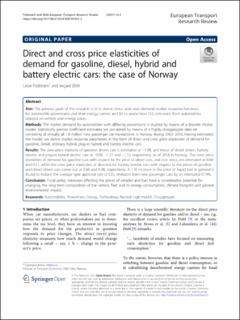| dc.contributor.author | Fridstrøm, Lasse | |
| dc.contributor.author | Østli, Vegard | |
| dc.coverage.spatial | Norway | en_US |
| dc.date.accessioned | 2021-07-27T13:10:26Z | |
| dc.date.available | 2021-07-27T13:10:26Z | |
| dc.date.created | 2021-01-18T10:26:14Z | |
| dc.date.issued | 2021-01-04 | |
| dc.identifier.citation | European Transport Research Review. 2021, 13:3, 1-24. | en_US |
| dc.identifier.issn | 1867-0717 | |
| dc.identifier.uri | https://hdl.handle.net/11250/2765397 | |
| dc.description.abstract | Aim: The primary goals of this research is (i) to derive direct and cross demand market response functions for automobile powertrains and their energy carriers and (ii) to assess how CO2 emissions from automobiles depend on vehicle and energy prices. Methods: The market demand for automobiles with differing powertrains is studied by means of a discrete choice model. Statistically precise coefficient estimates are calculated by means of a highly disaggregate data set consisting of virtually all 1.8 million new passenger car transactions in Norway during 2002–2016. Having estimated the model, we derive market response parameters in the form of direct and cross price elasticities of demand for gasoline, diesel, ordinary hybrid, plug-in hybrid and battery electric cars. Results: The own-price elasticity of gasoline driven cars is estimated at −1.08, and those of diesel driven, battery electric and plug-in hybrid electric cars at –0.99, −1.27 and −1.72, respectively, as of 2016 in Norway. The cross price elasticities of demand for gasoline cars with respect to the price of diesel cars, and vice versa, are estimated at 0.64 and 0.51, while the cross price elasticities of demand for battery electric cars with respect to the prices of gasoline and diesel driven cars come out at 0.36 and 0.48, respectively. A 1 % increase in the price of liquid fuel in general is found to reduce the average type approval rate of CO2 emission from new passenger cars by an estimated 0.19%. Conclusion: Fiscal policy measures affecting the prices of vehicles and fuel have a considerable potential for changing the long term composition of the vehicle fleet and its energy consumption, climate footprint and general environmental impact. | en_US |
| dc.language.iso | eng | en_US |
| dc.publisher | SpringerOpen | en_US |
| dc.rights | Navngivelse 4.0 Internasjonal | * |
| dc.rights.uri | http://creativecommons.org/licenses/by/4.0/deed.no | * |
| dc.title | Direct and cross price elasticities of demand for gasoline, diesel, hybrid and battery electric cars: the case of Norway | en_US |
| dc.type | Peer reviewed | en_US |
| dc.type | Journal article | en_US |
| dc.rights.holder | © The Author(s). 2021 | en_US |
| dc.source.articlenumber | 3 | en_US |
| dc.description.version | publishedVersion | en_US |
| cristin.ispublished | true | |
| cristin.fulltext | original | |
| cristin.qualitycode | 1 | |
| dc.identifier.doi | 10.1186/s12544-020-00454-2 | |
| dc.identifier.cristin | 1872934 | |
| dc.source.journal | European Transport Research Review | en_US |
| dc.source.volume | 13 | en_US |
| dc.source.pagenumber | 1-24 | en_US |
| dc.relation.project | Norges forskningsråd: 280989 | en_US |

